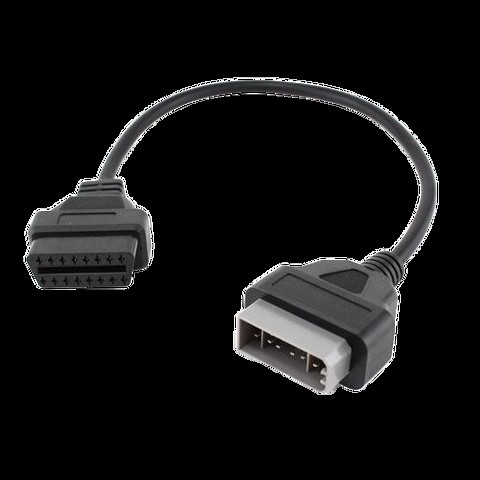Understanding your vehicle’s diagnostic system is crucial for effective maintenance and repair. Many car owners often find themselves asking: Can you check OBD1 with an OBD2 scanner? This is a common question, especially when dealing with older vehicles. Let’s delve into the world of OBD1 and OBD2 to clarify compatibility and explore the right diagnostic approaches.
Decoding OBD1: The Original On-Board Diagnostics
OBD1, short for On-Board Diagnostics first generation, was the earliest attempt to standardize vehicle diagnostics. Implemented in vehicles before the mid-1990s, OBD1 systems varied significantly between manufacturers. Each car maker had their own set of diagnostic codes, connector types, and communication protocols. This lack of uniformity meant that a diagnostic tool for one brand might be completely useless for another. OBD1 systems were less comprehensive, typically providing basic emission-related information.
OBD2: A Standardized Diagnostic System
OBD2, the second generation of on-board diagnostics, emerged as a mandated standard in the United States in 1996 and subsequently adopted globally. The key improvement with OBD2 was standardization. It introduced a universal 16-pin diagnostic connector, a standardized set of diagnostic trouble codes (DTCs), and common communication protocols across all makes and models. OBD2 systems offer more in-depth data, covering emissions, engine, transmission, and sometimes even chassis and body systems. This standardization made vehicle diagnostics more accessible and user-friendly.
OBD1 vs OBD2: Key Differences in Diagnostics
The fundamental difference between OBD1 and OBD2 lies in standardization and capability. OBD1 was manufacturer-specific and less comprehensive, while OBD2 is standardized and offers broader diagnostic coverage. From a practical standpoint, this means:
- Connectors: OBD1 connectors are varied and manufacturer-specific, whereas OBD2 uses a standard 16-pin connector.
- Diagnostic Codes: OBD1 codes are not standardized, making interpretation challenging without manufacturer-specific resources. OBD2 codes are standardized across the industry.
- Protocols: OBD1 employs diverse communication protocols. OBD2 utilizes a set of five standardized protocols, ensuring greater compatibility.
- Information Available: OBD1 systems provide limited data, mainly emissions-related. OBD2 offers a wider range of data parameters, enhancing diagnostic capabilities.
Can You Use an OBD2 Scanner on an OBD1 Car? The Compatibility Question
Now, back to the main question: Can you use an OBD2 scanner on an OBD1 car? The straightforward answer is no, generally you cannot directly use an OBD2 scanner on an OBD1 vehicle. This is due to the fundamental differences in their communication protocols and connector types. An OBD2 scanner is designed to communicate using standardized OBD2 protocols through a 16-pin port. OBD1 vehicles lack this standardized port and use different communication methods that OBD2 scanners are not equipped to understand.
Using a simple adapter to physically connect an OBD2 scanner to an OBD1 port will not bridge the communication gap. Adapters can change the connector shape, but they cannot translate the diagnostic protocols. Think of it like language – an adapter is like a plug adapter for electronics, not a language translator.
Diagnosing OBD1 Vehicles: What You Need
To effectively diagnose OBD1 vehicles, you will need:
-
An OBD1 Compatible Scan Tool: These are specialized scan tools designed to communicate with the various OBD1 protocols. High-end professional scan tools often have backward compatibility with OBD1, as well as supporting OBD2.
-
OBD1 Adapter Cables: Depending on the make and model of your OBD1 vehicle, you may require an adapter cable to connect the OBD1 scan tool to the vehicle’s diagnostic port. These adapters bridge the physical connector difference.
For example, older Nissan vehicles often use a 14-pin OBD1 connector:
Toyota vehicles with OBD1 systems might utilize a 22-pin port, often found in the engine bay:
For such ports, a Toyota 22-pin OBD1 adapter is necessary:
-
Vehicle-Specific Information: Due to the lack of standardization in OBD1, having access to vehicle-specific repair manuals or diagnostic information can be very helpful for interpreting codes and understanding system behavior.
Identifying Your Vehicle’s OBD System
If you are unsure whether your vehicle is OBD1 or OBD2, consider these points:
-
Manufacturing Year: Vehicles manufactured in 1996 or later in the US are typically OBD2. However, some vehicles before 1996 could be OBD2, and some after might still be OBD1 in certain regions or models. As a general guideline, vehicles older than 1996 are highly likely to be OBD1.
-
Check the Diagnostic Port: OBD2 ports are standardized 16-pin connectors, usually located under the dashboard on the driver’s side.
OBD1 ports vary in shape and location, sometimes found in the engine bay or under the dash, and are not the standard 16-pin shape.
-
Consult Your Vehicle Manual: Your vehicle’s owner’s manual should provide information about its diagnostic system.
-
Online Vehicle Lookup Tools: Some online resources and vehicle part websites allow you to input your vehicle’s year, make, and model to determine its OBD type.
Conclusion: Choosing the Right Diagnostic Path
While OBD2 scanners are incredibly useful for modern vehicles, they are not compatible with OBD1 systems. Attempting to use an OBD2 scanner on an OBD1 car, even with an adapter, will not work. For diagnosing OBD1 vehicles, you need specialized OBD1-compatible scan tools and potentially adapter cables. Understanding the differences between OBD1 and OBD2 and correctly identifying your vehicle’s diagnostic system is the first step to effective car maintenance and repair. Using the right tools for the job ensures accurate diagnostics and saves time and potential frustration.
